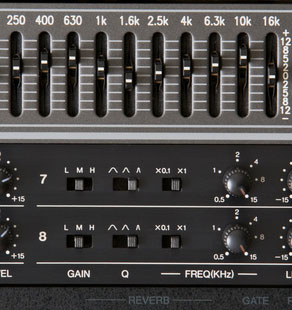Getting a great recording from a grand piano starts with mic placement. But with such a large instrument, there are just as many possible problems to run into as potential solutions. As with almost all audio endeavors, taking a little bit of extra time to get a good recording can save you lots more time and heartache later in the process.
You can read the full article about miking a grand piano here: http://www.prosoundweb.com/article/in_the_studio_close-miking_an_acoustic_piano/
Recording Tips and Techniques
Cleaning Up Muddy Tracks
Songs are described as muddy when the sound is unclear. In many cases, there is just too much going on at different frequencies to be able to hear each piece of the track distinctly. Some options for cleaning this up include EQ and panning. Start by saving your original sound files, then get your hands dirty and give it a try.
You can read the full article here: http://www.audiorecordingschool.com/blog/2013/03/11/dont-let-a-muddy-sound-ruin-your-mix/
Have A Backup Plan
Just because your recording sessions usually go well doesn’t mean they always will. Having a backup plan for equipment failures or other unexpected difficulties can mean the difference between a satisfied client and making looking unprofessional. By planning ahead, there will be much less stress in the event of a bad piece of gear. But if you only have one mic that will get the job done, you may be skating on thin ice.
You can read more here: http://www.audio-issues.com/home-recording-studio/plan-b/?utm_source=feedburner&utm_medium=feed&utm_campaign=Feed%3A+AudioIssues+%28Audio+Issues%29
Bring Dynamics Back To Your Mix
Many of the popular professional mixes today are loud, but lack dynamics. This has the effect of encouraging more of the same flat, loud mixes because “everyone is doing it”. It is possible to have it both ways, though. With a few easy tweaks, you can have a mix that is both loud and dynamic.
You can read the full article here: http://en.audiofanzine.com/mastering/editorial/articles/get-loud-masters-without-overcompressing.html
EQ Basics
 Equalization (EQ) is a big part of mixing and mastering, but for a new audio engineer it may be difficult to grasp the concepts that are involved with using EQ effectively. And because we are all about making hard concepts easy to understand, often by mocking overly complex terms or those who love to use them, but mostly making things fun and making them so anyone can understand.
Equalization (EQ) is a big part of mixing and mastering, but for a new audio engineer it may be difficult to grasp the concepts that are involved with using EQ effectively. And because we are all about making hard concepts easy to understand, often by mocking overly complex terms or those who love to use them, but mostly making things fun and making them so anyone can understand.
I’ve written several articles about EQ, starting at the beginning with What is Equalization, Usually Called EQ? If you can’t get enough of my awesome EQ writing (shya:)), you can find all post about equalization on our site here: https://www.homebrewaudio.com/tag/eq/
There’s a lot to be gained from learning by doing, but having a basic idea of what your goals are and what tools are available can improve the learning curve. And you can also learn EQ stuff from people other than me. I know! It’s a shock. But seriously…
You can read a great step-by-step guide to getting started with EQ here: http://audio.tutsplus.com/tutorials/production/the-basics-of-equalization/